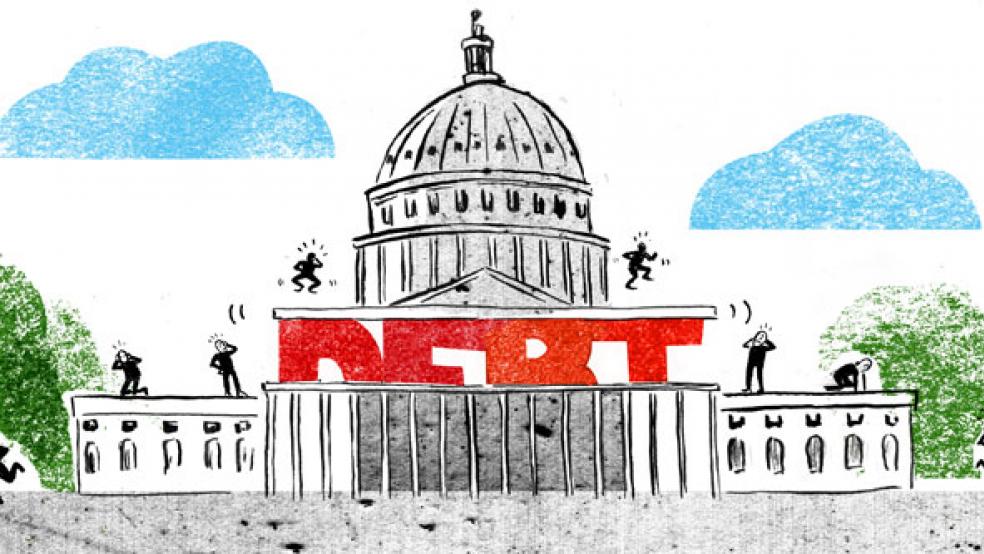With another debt ceiling crisis looming that threatens a first-ever default by the Treasury and another government shutdown, there is a growing school of thought in the Senate that lawmakers should swiftly increase the government’s legal borrowing authority in the next few weeks before adjourning for the summer.
After initially urging swift action on the debt ceiling, Treasury Secretary Steven Mnuchin conceded a week ago that the Treasury could probably make it through September without running out of cash to run the government and pay creditors.
Related: Team Trump Gets a 30-60 Day Reprieve from Raising the Debt Ceiling
Mnuchin’s ambivalence reflected sharp divisions within the Trump administration over how best to handle the thorny issue, with some like White House Budget Director Mick Mulvaney eager to use the debt ceiling as a bargaining chip this fall to achieve deep spending cuts.
But Senate Majority Leader Mitch McConnell (R-KY) and other senior GOP senators are increasingly inclined to resolve the debt ceiling issue in the coming weeks, before the August recess, rather than allowing it to fester and become enmeshed in partisan battles over defense and domestic spending this fall that could trigger another fiscal crisis.
Politico reports that there is also an “emerging consensus” among congressional leaders on both sides of the hill that the debt ceiling -- currently a staggering $20 trillion – should be raised by an amount large enough to preclude having to have another vote for at least several years.
Lifting the debt ceiling has been a politically onerous task dating back to the 1950s because neither party wants to be perceived by voters as accommodating runaway government spending. That’s ironic because the debt ceiling law has nothing to do with increased spending. Rather, it authorizes the Treasury to borrow money to cover spending already authorized by Congress and the President.
Related: Mulvaney’s Debt Ceiling Ploy Protects Treasurys, Not Social Security Checks
New debt ceiling authority almost always is decided with other major spending and tax disputes. That was the case in 2011 when Congress and the Obama Administration came within hours of default before breaking an impasse over spending and taxes. And the party in power frequently must make concessions to the minority to round up enough votes to pass the debt ceiling legislation in the two chambers.
Since 1960, Congress has acted 78 separate times to permanently raise, temporarily extend, or revise the definition of the debt limit. That happened 49 times under Republican presidents, 29 times under Democratic presidents, and each time, the stakes couldn’t have been higher.
Failure to raise the debt ceiling would do irreversible damage to the U.S. credit rating, touch off an uproar in U.S. and global markets, drive up the future cost of borrowing, postpone Social Security payments and tax returns, and force layoffs of non-essential government workers. Even the threat of a default in August 2011 prompted Standard & Poor’s to impose the first-ever downgrade to the country’s gold-plated credit rating.
Congress and the White House have extended the Treasury’s borrowing authority for long periods in the past to avoid having to repeat the excruciating exercise or get past an important congressional or presidential election without having to fight over the debt. In agreeing to a bipartisan budget deal in November 2015, the Obama administration and congressional Republican leaders suspended the debt ceiling through March 15, 2016, well past the 2016 election.
Related: Putting Trump’s ‘Historic’ $54 Billion Military Spending Boost Into Context
At that point, the debt ceiling was reset to reflect cumulative borrowing up until then. And the Treasury began taking “extraordinary measures” to effectively buy more time for the government to pay its creditors and cover revenue shortfalls to keep the government operating until it received new borrowing authority.
But as the government braces for what could likely be another nasty fight over the debt ceiling this fall if the House refuses to go along with the Senate in acting now, some are asking why we need a debt ceiling at all. Rather than extending it again, they say, why not simply repeal the statute?
For instance, Jason Furman, former chair of the White House Council of Economic Advisers in the Obama Administration, and Rohit Kumar, a former policy director and deputy chief of staff to McConnell, argued in a joint column in the Wall Street Journal this week that the debt limit “has outlived its usefulness as a mechanism for restraining the size of the national debt.”
“Put more precisely, we think that whatever residual value the debt limit may have is far outweighed by the risk that a potential U.S. default poses to the global economic order,” the Democrat and Republican wrote.
Related: New Debt Ceiling Deadline Could Ruin Lawmakers' Summer Vacations
Under the Constitution, Congress has the power to tax and spend as it sees fit, and to borrow money on the credit of the U.S., to cover shortfalls in revenue or emergency spending in times of crisis. Without this borrowing authority, the government would face a default on its debt to bondholders and miss payments to government agencies, taxpayers entitled to refunds, Social Security beneficiaries, defense contractors and a vast array of other creditors.
Related: Trump Could Face His First Fiscal Crisis Over Raising the Debt Ceiling
“Lawmakers are right to be concerned about steep increases in the debt,” Furman and Kumar wrote. “But those worries should be expressed when the policies that actually increase the debt are voted on. Once new policies become law, defaulting on interest payments or veterans’ benefits is hardly productive.”





